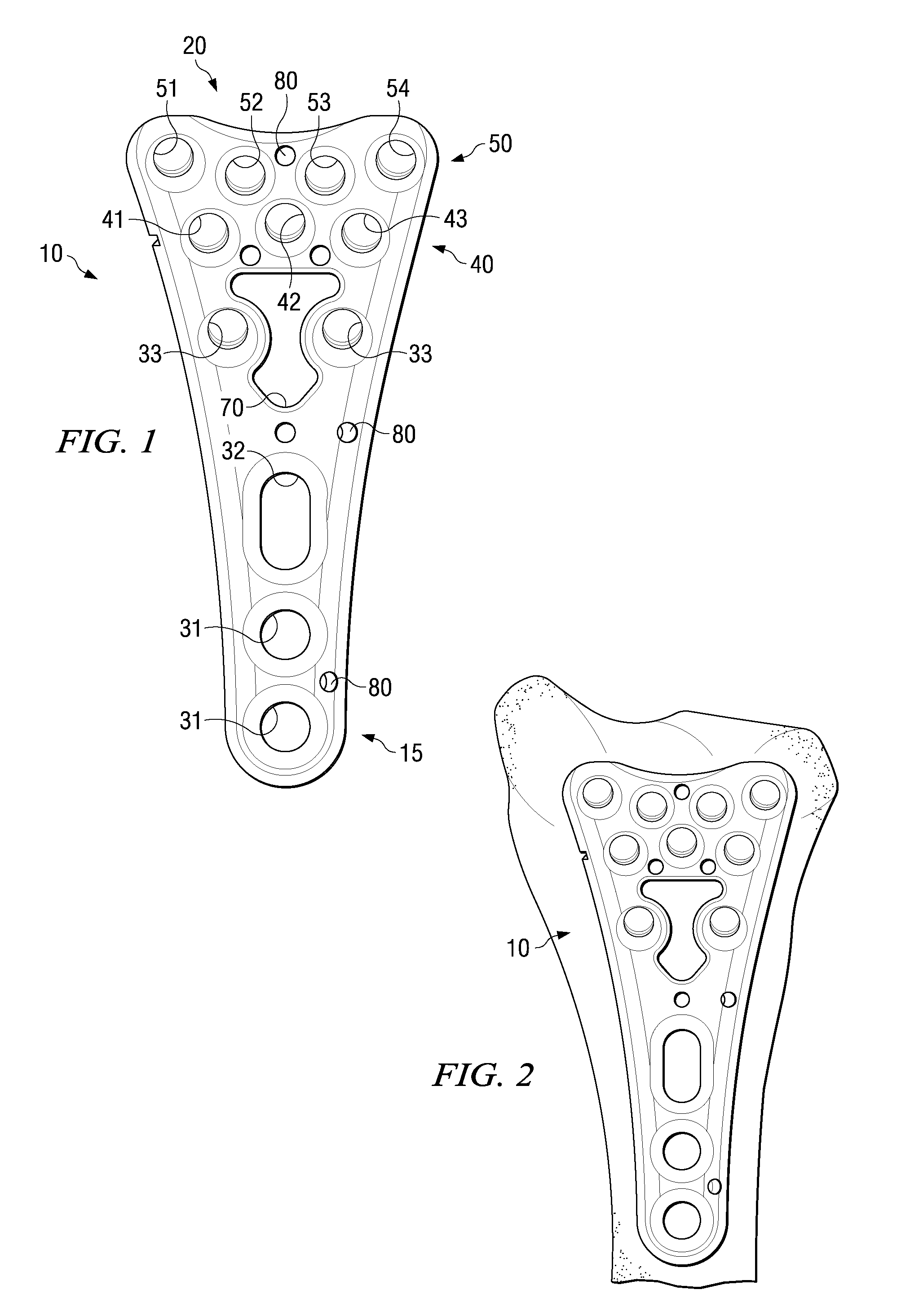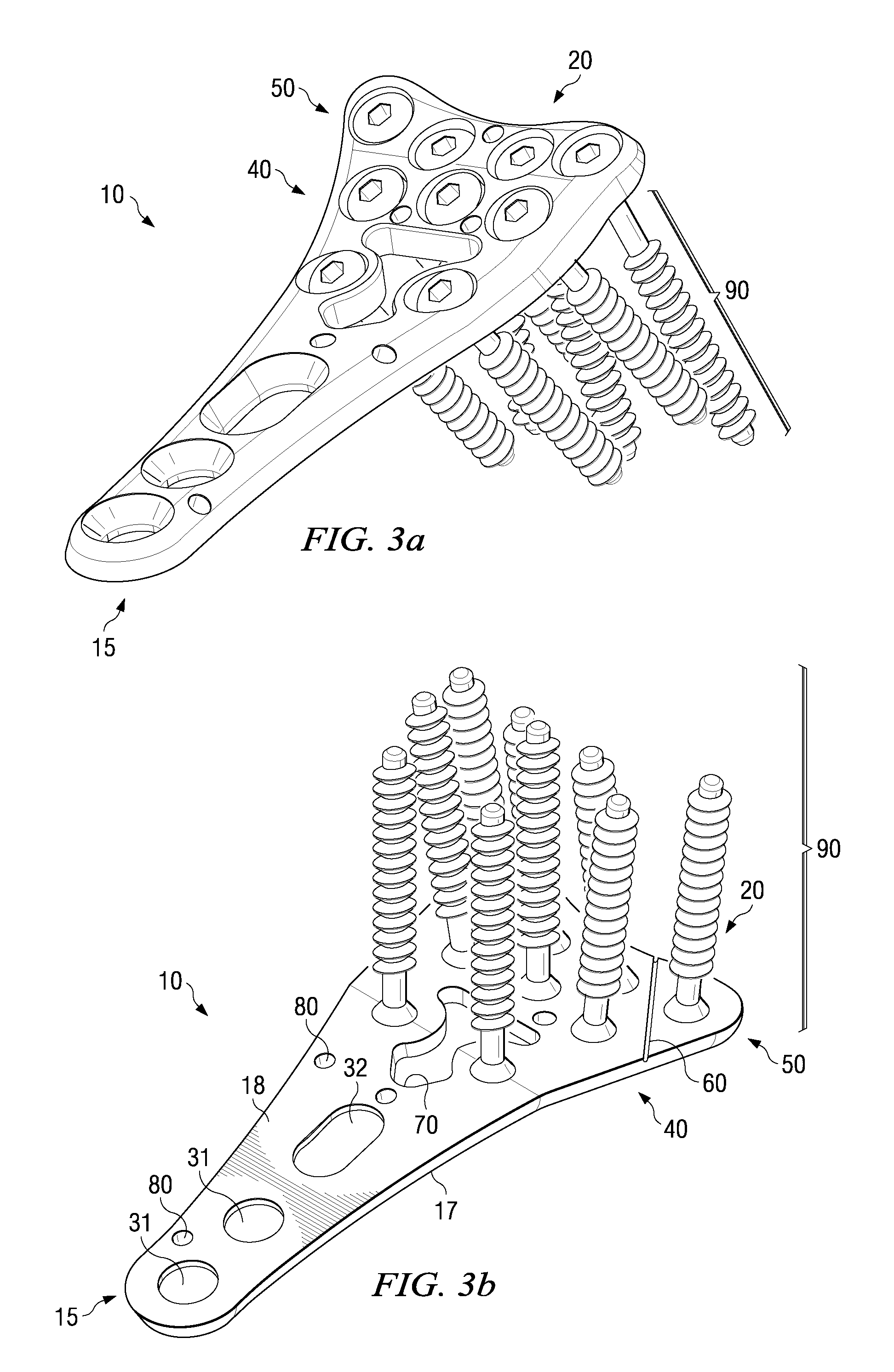[0005]The volar plate embodiments disclosed herein relate to
internal fixation devices designed in accordance with anatomical studies, with the goal of providing an effective stabilization framework for support of the
fracture site while allowing adequate
range of motion of the injured wrist for effective
physical therapy. By using a volar plate rigidly attached to the bone and physically supporting bone fragments in proper alignment, disclosed embodiments provide a support framework that allows
physical therapy to begin relatively early. This is important because it allows
range of motion and functional use of the injured wrist to be emphasized throughout the
treatment regimen, while ensuring that bone fragments are stably held in proper alignment for healing.
[0007]The curved upper surface of the volar plate, resulting from the angled attachment of the distal head portion to the proximal body portion, mimics the curvature of the distal volar surface of the
radius bone. The volar plate's anatomical shape also allows for
screw placement that essentially tracks the
articular surface of the distal radius, basically following the
subchondral bone contour line. The plate's shape provides anatomical alignment of the plate within the pronator quadratus fossa, allowing
bone screws to obtain purchase in the dorsal
subchondral bone without danger of protrusion into the joint space.
[0008]A complicating factor in designing a volar plate based on anatomical modeling is that studies have shown that the volar
surface geometry of the distal radius is not always standard, but varies depending upon the individual. To account for this variance, allowing for more precise fitting of the volar plate during surgical implantation, a crease may
score the bottom surface of the corner of the volar plate relating to the radial styloid, allowing the doctor to bend that corner of the distal head portion of the volar plate to adjust the fit based on a particular patient's bone geometry. Accordingly, disclosed embodiments provide for a volar plate designed to interact effectively with the patient's
bone structure, thus providing an effective base of support for a wrist fracture. By utilizing an anatomically designed volar plate, the disclosed embodiments reduce the risk of improper plate and
screw placement and provide for successful, reproducible outcomes when mounting the volar plate on the bone.
[0012]The volar plate may also contain a central cavity, located generally in the vicinity of the region of the volar plate where the distal head angles away from the proximal body. The central cavity may provide convenient access for the introduction of
grafting materials during the
treatment regimen. Furthermore, a plurality of mounting screw holes (or some other such means for fixation of the plate onto the bone) are located within the proximal body of the volar plate, allowing the plate to be mounted in place securely on the bone and / or to address more proximal fractures. One or more mounting screw holes are generally located towards the proximal end of the volar plate (and one or more of these mounting screw holes could be configured as an elongated slot, allowing longitudinal adjustment of the volar plate as it is being affixed by the surgeon), while two mounting screw holes would generally be located more distally, with one on either side of the central opening. All of these mounting screw holes allow the volar plate to be firmly fixed in place on the bone, providing a secure base for the stabilization framework. Finally, the volar plate may also include smaller holes for K-wires, allowing temporary fixation of the volar plate in place during the surgical procedure in such a way that the surgeon may correctly position and temporarily fix the volar plate prior to affixing it securely to the bone via
bone screws.
[0013]So generally, disclosed embodiments provide for a volar plate designed in accordance with the anatomical region of the distal radius, having a wider distal head portion that narrows to a generally flat proximal body, with the head angling up from the plane of the proximal body to form a concave upper surface. The head of the volar plate would generally have two rows of holes, allowing
bone screws or some other fixation means to be inserted through the volar plate to fix the position of bone fragments with respect to each other and with respect to the volar plate. The location and angle of the holes would provide for fixation of the fragments in accordance with the anatomical geometry of the distal radius, such that the screws in each row would generally follow a non-linear arc shape, converging in an interleaved manner to provide a secure stabilization framework for the bone fragments. The volar plate may further aid in healing of the fracture by incorporating a central cavity, which allows introduction of
grafting and / or bone void filler material. Due to unique design features, disclosed volar plate embodiments offer improved stabilization and support for the healing of bone fractures, while allowing for a range of motion for
physical therapy.
 Login to View More
Login to View More  Login to View More
Login to View More 


